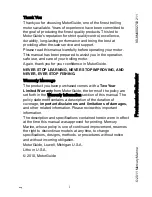
ASUS P4B266-M motherboard user guide
G-3
Device Driver. A software routine that links a peripheral device to the
operating system. It acts as a translator between the device and the
applications that use it. Each device has its own set of specialized
commands known only to its driver while the applications access devices
using high-level generic commands. The driver translates these
commands into the commands required by the devices.
DOS (Disk Operating System). A software that organizes how a
computer reads, writes, and communicate to the disks and various input/
output devices (such as keyboards, screens, serial and parallel ports,
printers, modems, etc.) connected to it. DOS was the most popular PC
operating system until the introduction of Windows.
DRAM (Dynamic Random Access Memory). A type of RAM that requires
refresh cycles to prevent the loss of the data stored in it. See also RAM
and SDRAM.
Expansion Card. A printed circuit card suchas an audio card, a video
card, or a LAN card that plugs into an expansion slot on the motherboard.
An expansion card add functions that are not present in the motherboard.
Flash ROM. A non-volatile memory device that retains its data even when
power is removed. This device is similar to EPROM, but unlike EPROM
which can be erased only using an ultra-violet light, flash ROM can be
electrically erased. Flash ROM is normally used for system BIOS, which
initiates hardware devices and sets up necessary parameters for the OS.
Since the flash ROM contents can be modified, you can update the BIOS
by yourself.
IDE (Integrated Drive Electronics). IDE devices integrate the drive
control circuitry directly on the drive itself, eliminating the need for a
separate adapter card (in the case for SCSI devices). UltraDMA/100/6633
IDE devices can achieve up to 100MB/sec transfers.
Internet. The global computer network composed of WANs and LANs that
uses TCP/IP to provide worldwide communications to homes, schools,
businesses, and the government.
I/O (Input/Output). The data transfers from the input devices like a
keyboard, mouse, or scanner, to the output devices like a printer or the
monitor screen.
I/O Address. The specific memory location for a particular device. Two
devices cannot share the same I/O address space.
Содержание P4B266-M
Страница 1: ...Motherboard P4B266 M User Guide ...
Страница 12: ...ASUS P4B266 M motherboard ...
Страница 20: ...ASUS P4B266 M motherboard ...
Страница 34: ...ASUS P4B266 M motherboard ...
Страница 38: ...ASUS P4B266 M motherboard ...
Страница 72: ...ASUS P4B266 M motherboard ...
Страница 83: ...Glossary This part lists the technical terms that you may encounter when reading this document ...
Страница 84: ...ASUS P4B266 M motherboard ...
Страница 91: ...Index This part contains an alphabetical list of the topics found in this document ...
Страница 92: ...ASUS P4B266 M motherboard ...









































